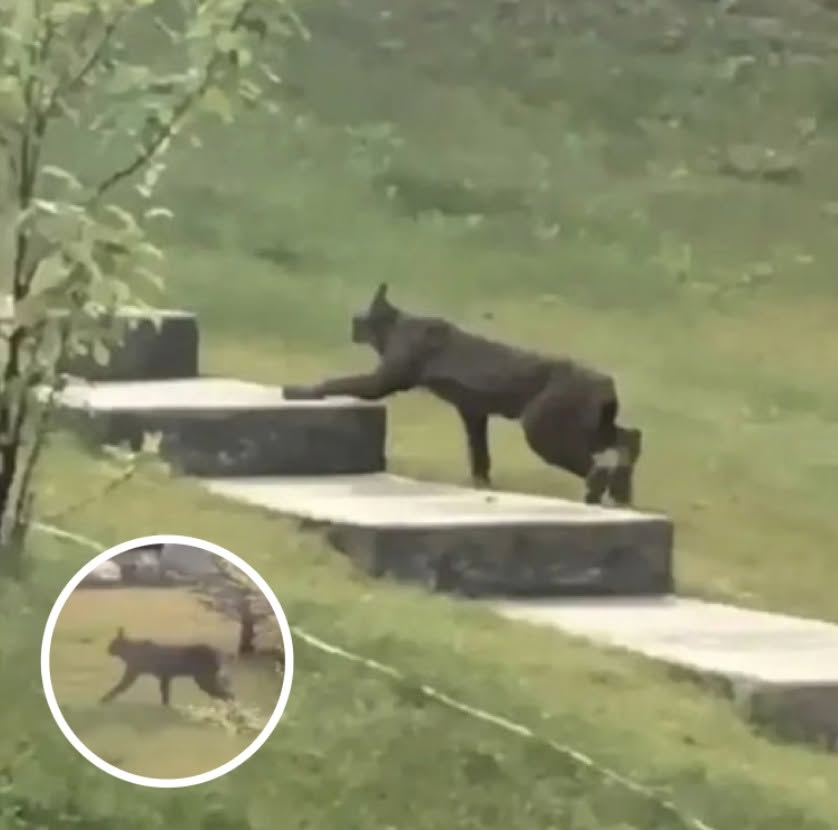Canadian scientists have made a discovery so rare, it’s left even the most seasoned wildlife experts stunned. For the first time ever, a melanistic Canada lynx—an animal previously known only through speculation and theory—was caught on camera. This extraordinary sighting has sparked global interest, not only for its visual rarity but for what it may reveal about climate, genetics, and the delicate balance of the natural world.
Typically, Canada lynx are known for their silvery-gray or reddish-brown fur, which helps them blend into snowy landscapes. But this particular lynx, captured in remote Canadian wilderness on a smartphone, displayed something unheard of in the species: a coat of deep, dark fur—a clear example of melanism, a genetic trait that results in excessive black pigmentation. Until this moment, there had never been confirmed visual evidence of a melanistic Canada lynx in the wild.

The footage, though brief, has already made waves in the scientific community. Wildlife researchers were thrilled by the breakthrough but quick to express concern. The lynx’s dark coloration, while visually stunning, could be a disadvantage in the snow-covered habitats it calls home. Unlike its lighter-coated relatives, this melanistic lynx might struggle with camouflage, potentially impacting its ability to stalk prey and evade predators. The very trait that makes it extraordinary could also make its survival more challenging.
This discovery has also reignited discussions surrounding the link between melanism and climate change. A 2014 study suggested that rising global temperatures may influence the appearance of darker coat colors in animals. Warmer climates often favor darker pigmentation due to increased UV protection and better heat absorption. Could the melanistic lynx be an evolutionary response to our warming planet? That’s one of many questions scientists are now asking as they work to learn more about this mysterious animal.
The lynx was seen climbing stairs, wandering across snowy terrain, and resting in the brush—its sleek black fur contrasting sharply with the winter backdrop. The video, now circulating across major news and conservation platforms, has become a symbol of nature’s unpredictability and resilience.
Beyond the scientific implications, the sighting of the melanistic Canada lynx serves as a reminder of how much we still don’t know about the animal kingdom. Nature continues to surprise and challenge us, reminding us that there are still phenomena hiding in plain sight, waiting to be understood. Each new discovery like this expands our knowledge of biodiversity and the remarkable adaptability of life in the wild.
But the moment also carries an urgent message. As human development, deforestation, and climate change threaten more wildlife habitats, the chances of encountering such rare and magnificent creatures grow slimmer. Conservationists are calling this sighting a wake-up call—a chance to double down on efforts to preserve the ecosystems these animals depend on.
The melanistic lynx isn’t just an anomaly. It’s a symbol of evolution in motion, a product of genetic variance meeting a changing world. It encourages deeper inquiry into how species adapt, how traits emerge, and how closely our own actions are tied to the future of every living creature on the planet.
Ultimately, the video is more than proof of a rare animal’s existence—it’s a powerful narrative of wonder, survival, and responsibility. It reminds us that despite all our technology and scientific advancement, the natural world still holds secrets. And when one is revealed, it’s not just a moment of discovery—it’s an opportunity to pause, reflect, and renew our commitment to protecting the magic that still exists in the wild.
